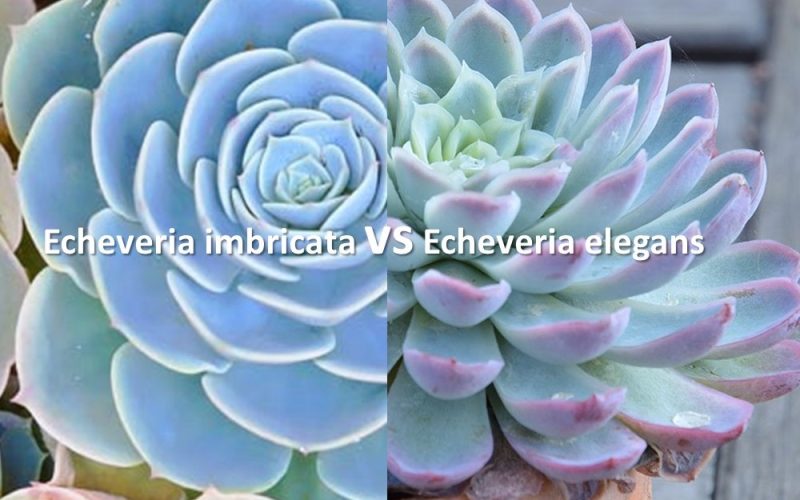To distinguish between Echeveria imbricata and Echeveria elegans, focus on their leaf shape and growth habit. In summary to Echeveria imbricata vs elegans, the shape of E. imbricata is a flatter and wider rosette, and its leaves are broader, while E. elegans forms a more compact, rounded rosette, and its leaves are spoon-shaped.
Anyway, Echeveria imbricata vs elegans can be challenging because of the various types of Echeveria elegans and Echeveria imbricata with vibrant colours. In addition, their size and colours may be changed in different environments and situations. Hence, to distinguish between them, you need to have an overview of their appearance.
Here, I provided a list of key features with their images to identify Echeveria imbricata and Echeveria elegans. Then I compare these characteristics. If you are ready, let’s start.
Echeveria Imbricata: A Compact Beauty

Echeveria imbricata is a striking succulent known for its compact and tidy appearance. Here’s a breakdown of its key features:
- Rosette: It forms a tight, symmetrical rosette of fleshy leaves.
- Leaf Color: The leaves are typically a beautiful pale blue-green, often with a powdery coating. Especially in Echeveria imbricata “Blue Rose”. Please read my other post to find more types of Blue Echeveria.
- Leaf Shape: The leaves are spoon-shaped and overlap perfectly, creating a compact and uniform look.
- Size: This Echeveria is relatively small, making it ideal for containers or rock gardens.
Its compact growth habit and attractive foliage make it a popular choice for succulent enthusiasts.
Echeveria Imbricata: Hybrids or Not?
Yes, Echeveria imbricata is a hybrid. It’s a cross between:
- Echeveria secunda
- Echeveria gibbiflora ‘Metallica’.
Echeveria elegans: A Delicate Beauty

Echeveria elegans, often referred to as the Mexican Snowball, is a charming succulent with a graceful appearance. This lovely Echeveria is also known as Mexican Snowball. It’s important to note that while it is the most common name, there might be regional variations or informal names used in specific areas.
- Rosette: It forms a compact, symmetrical rosette of fleshy leaves.
- Leaf Color: The leaves typically start as a pale blue-green, often with a powdery coating. Under bright light conditions, the leaf tips may develop a beautiful pink blush. (Read my other post about blue types of Echeveria)
- Leaf Shape: The leaves are spoon-shaped and overlap perfectly to create the rosette.
- Flowers: In spring, Echeveria elegans produces delicate, bell-shaped flowers on tall stems. These flowers are usually pink with yellow tips.
This species is beloved for its soft, powdery appearance and the way it forms dense mats of rosettes over time. In proper care conditions, it can be one of the stunning large Echeveria types.
Echeveria elegans: Hybrids or Not?
Echeveria elegans, on the other hand, is not considered a hybrid. It’s a pure species.
Echeveria Imbricata vs Elegans
While both Echeveria imbricata and Echeveria elegans are popular succulents with striking appearances, they have distinct characteristics.
Echeveria imbricata
- Hybrid: Result of a cross between Echeveria secunda and Echeveria gibbiflora ‘Metallica’.
- Rosette: Tends to be flatter and wider, often described as “saucer-like”.
- Leaves: Broad, flat, and overlapping, creating a compact, mounding growth habit.
- Size: Generally larger than Echeveria elegans.
Echeveria elegans
- Pure species: Not a hybrid.
- Rosette: More compact and spherical, often described as “snowball-like”.
- Leaves: Spoon-shaped and overlapping, creating a dense, rounded rosette.
- Size: Smaller than Echeveria imbricata, often used in hanging baskets.
Echeveria imbricata vs elegans: Using a Tool
Allow me to suggest a reliable tool to identify plant species: the “Google Lens”. It is one of the best ways to identify succulents and other indoor and outdoor plants. I also tested it for wild plants and found it perfect.
Working with this free online tool is very easy and reliable. It can also detect plant diseases. However, distinguishing between some close varieties or species may be challenging. You can easily identify most purple Echeverias by it, but for Echeveria imbricata vs elegans, you must mix a combined detection method of a verified tool and your spots.
Conclusion
Here I told you about the key differences to look for Echeveria imbricata vs elegans and compare them. For example, I told you about their Rosette shape and you found out Imbricata has a flatter, wider rosette, while Elegans is more compact and rounded.
In addition, in terms of their Leaf shape, Imbricata has broader, flatter leaves, while Elegans have spoon-shaped leaves. However, the plant size can vary depending on caring conditions, but overall, the Imbricata tends to be larger than elegans.
Please tell me about your experiences in identifying plant species in the comments.

Elahe Rabiei
Hi, I’m Elaheh. My Academic major is plant protection, and houseplants are my expertise. As a houseplant lover, my house is full of indoor plants and it is my passion to take care of them. Hence, I’m here to share my knowledge and experience about growing healthy houseplants. I am also a plant protection advisor, so feel free to ask me any questions you may have.

